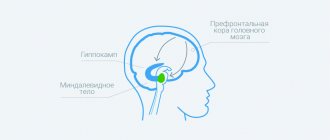Depression is a condition that can be caused by somatic or nervous disorders, or be a consequence of stress, family troubles, or other problems in personal or social life. It can also develop absolutely without any external reasons, against the background of complete well-being - in this case, the cause, as a rule, is a violation of the level of neurotransmitters in the brain.
To receive quality treatment, the patient must realize that bad moods can occur in absolutely healthy people. While with depression, low mood or depression lasts for at least two weeks and may be accompanied by sleep disturbances, appetite, decreased performance and other symptoms, which we will discuss later.
Depression can occur in people of any age, regardless of gender. The death of a close friend, relative, loved one or child can be a catalyst for progressive feelings of sadness. Sometimes the only beloved child, unexpectedly for those around him, becomes unsociable and withdrawn. We need to try to figure out the reasons as quickly as possible and help him gain faith in himself. A simple misunderstanding among classmates and friends or the appearance of another child in the family can disrupt the psychological balance and become the root cause of depression.
How depression manifests itself
The main manifestation of depression is a persistent decrease in mood, the cause of which most often cannot be explained. The depressed mood itself is different from the grief that you experience during various misfortunes. A person suffering from depression usually cannot formulate his experiences due to the unusualness of the sensations, their difference from everything that he had previously experienced in life. Such people often resort to comparisons: “there is heaviness, stone, darkness in my soul”, “everything has lost its meaning, joy”, “life has become difficult”, “I feel as if I had a super-severe flu.”
How to identify apathetic depression in a person
The first sign of developing apathetic depression is a decrease in the intensity of life. A person immediately loses interest in vigorous activity and overall motivation decreases. At the same time, the mood and usual interests may not disappear, just like the previous way of life. A psychological problem begins to develop from within when all actions lose their meaning.
Those around a person with apathetic depression can only notice the disorder by being attentive. For example, even the initial stage of the problem is characterized by a decrease in facial expressions and emotionality in conversation. Although a smile can still appear on the face. But it will seem artificial and slower. Some patients describe their condition at this moment as if in a dream. It’s as if they see themselves as parties and continue to monotonously fulfill their obligations at work and at home.
If you start talking to a person who is developing apathetic depression, he may express internal concerns. The disorder often occurs with insomnia and mild panic attacks.
What are the causes of depression?
The cause of depression is inherited biochemical disorders at the level of the central nervous system. And also certain personality types: hypersensitive, scrupulous, pedantic, overly sensitive to failures, impressionable, vulnerable people are more susceptible to depression than others. We can talk about a risk group for depression: women suffer from depression much more often than men. If we talk about age, the lower limit for this group is 18-20 years old, the upper limit is 35-40. There is also a special form of depression that begins during menopause.
Is it possible to diagnose yourself?
Recognizing depression is not an easy task, but you can suspect the disease based on a combination of the following factors:
- diurnal mood swings with worsening in the first half of the day, especially in the morning, and improvement in the evening;
- a sharp decrease in mood is combined with inhibition of movements and thoughts;
- persistent, causeless decrease in mood over a period of weeks or months or periodically in the fall and spring;
- cases of prolonged, causeless depressed mood, if there have been suicide attempts in the family by close relatives, especially on the maternal side, or periodic situations of binge drinking among close relatives;
Their appearance is characteristic: a bent posture, people look much older than their years, they have dry, flaky skin, their hair splits, falls out, often turns grey, and their nails are brittle.
Depression and suicidal thoughts
Signs of suicidal behavior
Depression carries a high risk of suicide. Anyone who has suicidal thoughts or intentions should be taken seriously. Do not leave such people alone and contact your local doctor or psychiatrist immediately. If your city has a mental health hotline, call their number or make sure the sick person contacts a specialist.
If you or someone you care about suffers from acute depression, then you simply need to know the first signs of suicidal behavior. It is possible to prevent suicide. And knowing the warning signs that indicate a person’s tendency to commit suicide will help you with this.
The most effective way to prevent suicide in acute depression is to know the risk factors and pay attention to the warning signs. Do not ignore such signals. Learn how to respond to them. You can save someone's life.
How common is suicide?
Suicide is a theoretically preventable public disease. Deaths due to suicide account for 1% of all deaths in the United States each year. In 2001, suicide was the 11th leading cause of death in this country.
Among people aged 15 to 24, suicide is the third leading cause of death. Men die from suicide at four times the rate of women. Moreover, 73% of all suicide victims are white men.
What are the risk factors for suicidal behavior?
Risk factors for suicidal ideation vary by age, gender and ethnic group. However, you can often find a combination of these factors.
90% of people who die by suicide had acute depression or another diagnosable mental illness. Suicide is also common in cases of alcohol or drug addiction. Especially if this addiction coexists with a mental disorder.
Unpleasant or dramatic events in life, combined with depression, can also lead a person to commit suicide. But neither suicide nor suicidal behavior is a normal response to life's adversities.
Risk factors for suicide include:
- One or more past suicide attempts
- Genetic predisposition to mental illness or alcohol or drug addiction
- Cases of suicide in the family
- Experienced domestic violence
- Physical or sexual violence
- Presence of firearms in the house
- Imprisonment or infringement of human freedom
- Exposure to other suicidal people
Are there warning signs of suicidal behavior?
Warning signs that a person is thinking or attempting suicide include:
- Constant conversations and thoughts about death
- Clinical depression—feelings of deep sadness, loss of interest, trouble sleeping, and changes in appetite—that gets worse
- "Death Quest", testing fate through behavior that could lead to death, such as running a red light or driving fast
- Loss of interest in favorite activities
- Constant conversations about hopelessness, helplessness and worthlessness
- Putting things in order, trying to complete unfinished business, changing a will
- Replies such as “It would be better if I weren’t here” or “I want to leave”
- Sudden mood swings, from deep sadness to sudden feelings of happiness
- Talking about suicide
- Sudden visits or phone calls to once dear people
Pay special attention to people who show the warning signs listed above or have attempted suicide in the past. According to the American Foundation for Suicide Prevention, 20% to 50% of suicide victims have attempted suicide in the past.
What to do if a person has acute depression and is at risk of committing suicide?
First of all, if a person you know is suffering from acute depression and you see that he is capable of suicide, do not ignore his statements.
. Listen to his words. Ask this person what his plans are for the future. But under no circumstances argue with him, thus trying to dissuade him from committing suicide. It’s better to let this person know that you care about him, that you care about him and are always ready to listen to him and help him. Avoid sentences like “You have something to live for” when talking to him.
If someone you know is depressed and expresses suicidal thoughts, engages in suicidal behavior, or attempts suicide, do not leave that person alone with their problems. Listen to him, but don't argue with him. Seek professional help immediately.
People suffering from depression are at greatest risk of committing suicide. This is one of the key symptoms of this disease. Several studies have shown that the neurotransmitter serotonin plays a central role in the neurobiology of suicide. Studying suicide victims, scientists came to the conclusion that these people had low levels of serotonin in the brain and spinal cord.
Moreover, suicide has a hereditary predisposition. Remember, any statements about suicide should be taken seriously and the intervention of specialists is simply vital.
Who to turn to for help with depression and risk of suicide?
Encourage the patient to think that he needs to see a specialist in mental disorders, that is, a psychologist. If the patient does not believe that the doctor can help him, do not give up and, if necessary, go to the doctor with him.
If a loved one is on the verge of committing suicide, do not leave him alone under any circumstances. Hide any object with which he can cause physical harm to himself, weapons, knives, and so on. Take him to the doctor immediately and support him during this visit.
Support the patient during treatment. Remind him to take prescribed medications and attend necessary therapy groups.
If depression is combined with a somatic illness, should you see a psychotherapist?
Yes. It should be noted that depression can manifest itself in various “masks”, for example: pain of various types, breathing problems (resembling asthma), binges, attacks of so-called vegetative-vascular dystonia. Diagnosis, in this case, can be helped by the mood swings characteristic of typical depression during the day, as well as other manifestations, such as rapid heartbeat, dilated pupils, and dry skin. Lack of appetite and constipation, also characteristic of depression, can be fatal as they last for several months.
Is depression curable?
Yes, but it won't happen overnight. Depression can be successfully treated in most cases. Depending on the type of depression and the severity of the disease, treatment and the time required for recovery can vary greatly. Severe cases of depression are treated in psychiatric clinics with antidepressants and tranquilizers. Moderately severe and mild depression is treated with a combination of antidepressants and various methods of psychotherapy or psychotherapy alone. In difficult cases, complete relief from depression is possible within six months to a year. If medications are used in treatment, the time frame is reduced to 3-5 months. There is also ultra-short psychotherapy, which allows you to significantly reduce the symptoms of depression in 5-10 meetings with a psychotherapist (psychotherapeutic sessions).
Types and classification of depression
According to modern concepts, depression can be unipolar (episode) or part of the structure of bipolar affective disorder. In domestic psychiatry there are more detailed classifications. Simple and complex depression are considered from the perspective of all possible clinical options for the course of the disease.
Simple
Simple forms of depressive episodes have pronounced symptoms that can be assessed within a specific syndrome. They are easy to diagnose and treat. In some cases they can be combined or alternated.
Melancholic
With melancholic (also called melancholy) depression, patients experience typical symptoms of the disease. Along with them, the following signs are noted:
- yearning;
- feeling of mental pain;
- vital melancholy – physical manifestations of depressed mood (pain in the abdomen, heart area, discomfort in the right hypochondrium);
- the surrounding world is perceived in gloomy tones;
- old pleasures have lost their appeal;
- life seems gloomy and the future hopeless;
- speech is slow, quiet;
- information is difficult to perceive and analyze, which leads to false forgetfulness;
- thinking is depressed;
- suicidal tendencies.
The behavior of patients is monotonous and slow. They wear mournful expressions on their faces, sit in depressed poses, with their heads bowed low. There is no desire for any type of activity.
In young patients, apathy, reflection, and depressed mood are more pronounced. The classic course is typical for middle-aged people. Melancholic depression is common in the elderly.
Alarming
Anxious depression lives up to its name. There are agitated and inhibited variants of the flow. Symptoms occur against a background of overwhelming anxiety that people feel physically.
Agitated depression is characterized by periods of psychomotor agitation. Patients are fussy, fiddle with things with their fingers, and speak quickly. In severe cases, delusions are possible.
The inhibited variant is more reminiscent of the classic course of the disease. However, in this case, oppression of thinking and inaction reach their maximum. Patients do nothing, do not perceive speech addressed to them well, and do not experience any impulses.
Anesthetic
Mental anesthesia is the loss of emotional response in response to any stimuli. Depression with a predominance of this syndrome comes in several forms:
- Purely anesthetic. Emotionality comes to the fore, somewhat pushing aside other symptoms. May be supplemented by physical inactivity, hypochondria, depersonalization, and delusional ideas.
- Dreary and anesthetic. The mood changes throughout the day with a predominance of depressing melancholy. Patients complain of moral weakness, painful discomfort in the heart area, and inactivity. The speech reveals ideas of self-accusation.
- Anxiety-anesthetic. Against the background of external manifestations of anxiety, agitation and confusion of thoughts (influx) appear, intensifying in the evening. The main complaint is a painful feeling of “inner emptiness.”
Adynamic
The clinical picture is dominated by severe general weakness, decreased mental and physical performance, and impotence. They can occur in the ideational, motor or mixed variant while maintaining typical symptoms. That is, the main role is played by the type of inhibition - mental or somatic.
Apathetic
A person cannot engage in any mental or physical activity, since all desire or aspiration disappears. The same applies to any motivation to be active. Such depressions are apatomelancholic or apatodynamic - in accordance with the prevailing syndromes.
Dysphoric
Patients become sharply irritable and aggressive. Outbursts of anger in low mood occur spontaneously; everyday situations become the source of negativity. A hateful attitude towards the world manifests itself in the form of threats, swear words, and ridiculous actions. There is a feeling of oppressive tension.
Additional inclusions
Thus, simple depressive episodes are characterized by a predominance of clear syndromes with a weakening of other symptoms. In some cases, additional inclusions may appear - elements of delirium, hallucinations, catatonia (motor disorders). Severe exacerbation may be accompanied by oneiroid-type clouding of consciousness.
Complex
Complex depression has a more varied clinical picture. There are senestohypochondriacal and with additional symptoms (delusional ideas, hallucinosis, catatonia). Mental disorders are deeper, more changeable, and more strongly disrupt a person’s quality of life.
Patients with senestohypochondriacal depression irrationally focus on their physical health. They can be recognized by bizarre complaints of strange sensations in different parts of the body, especially internal organs. Mood disorders fade into the background, but still persist.
With complex depression, full-fledged delusional-hallucinatory and motor disorders can develop. The severity is individual - from single twitching to a stuporous state.
Protracted and chronic
The protracted nature of the disease only indicates a longer persistence of symptoms. The clinical picture may remain the same or change slightly. Such a depressive episode can be a single episode and ends without long-term consequences.
If signs of the disorder persist for a long time and recur, they speak of a chronic course of depression. In this case, the symptoms may change with each exacerbation, as well as the severity of the manifestations. The diagnosis corresponds to recurrent depressive disorder.
If hypomanic syndrome is added, there is a risk of developing bipolar affective disorder. Repeated episodes of depression and mania can alternate in different clinical variants.
Other
The word “depression” itself implies any variant of a negatively depressed mood. In addition to domestic classifications, other conditions with similar symptoms fit under this heading. They cannot always be identified within the framework of ICD-10, so they are considered separately.
Clinical
Major depressive disorder (MDD) is a broad symptom complex that resembles mixed depression. The diagnosis is used in the American DSM-5 classifier and has different degrees of severity. The disturbances are present most of the day, usually daily.
Any associated psychomotor disturbances may be present in the structure of clinical depression. Some patients note the appearance of psychotic symptoms or the absence of bad mood. Residual manifestations persist in 20-30% of patients without receiving rational therapy.
Masked (somatized)
When typical manifestations (negative emotional background, melancholy) are not clearly expressed against the background of somatic complaints, they speak of hidden/maneuvered depression. At the same time, affective disorders are hidden, fading into the background. Patients note various symptoms characteristic of somatic diseases (gastritis, hypertension).
The dominant clinical sign may be nausea in depression (or “lump in the throat”). People turn to doctors of different profiles, who even find “their” diseases. But standard symptomatic therapy does not have a significant effect. And only in rare cases do they receive a referral to a psychiatrist.
Against the background of a latent course of the disorder, nervous exhaustion develops. “Masks” most often are the following diseases:
- vegetative-vascular dystonia;
- unexplained pain syndrome with any localization;
- sleep disorders;
- transient hypertension;
- cardioneurosis;
- migraine;
- menstrual irregularities;
- functional dyspepsia (like chronic gastroduodenitis).
The danger comes from late detection of the true problem, since many months of visiting hospitals only worsens the condition. Treatment of masked depression allows you to get rid of most somatic symptoms.
Atypical
Patients with atypical (or “laughing”, “smiling”) depression seem from the outside to be absolutely normal, and even happy. They are prosperous, efficient, and lead an active lifestyle. However, the internal tension is so great that people themselves deny the existence of violations.
Hiding psychological pain and troubles behind a smile is not a way to get rid of a real disorder. Patients believe they are good at coping with their problems and therefore respond poorly to treatment.
Psychotic
A severe form of a depressive episode may be accompanied by psychotic disorders. At the peak of exacerbation, false beliefs (delusional ideas) and hallucinosis arise. The condition may give way to mania. Patients with this form of the disease require urgent hospital treatment.
Psychogenic
Psychogenic (or reactive, exogenous) depression develops in response to an important stress factor for a person. Common reasons are divorce from a partner, death of a loved one, dismissal. People who have been in a state of psycho-emotional stress for a long time are also at risk.
Seasonal
Relapses of negative symptoms in some people are associated with the time of year. Most often, exacerbations occur on cloudy days and seasons (autumn, winter), when the amount of sunlight decreases.
Some people experience depression in the spring. The causes of spring depression are individual - from hay fever (seasonal allergies) to unjustified expectations, loneliness. It does not pose a particular danger, it responds well to treatment.
Resistant
Treatment-resistant depression (refractory) is a severe variant of the disease in which standard pharmaceutical regimens are ineffective. Associated with an initially severe course of depression, often protracted and often recurrent.
To correct the condition, a re-evaluation of the diagnosis and previous therapy is carried out. In some cases, it is necessary to change doctors until a rational approach is selected.
Anaclitic
Anaclysia implies the presence of a painful dependence on another person, usually in the example of a mother and child in the first year of life. Feelings of melancholy, anxiety, and ideational inhibition appear when the baby is separated from the woman. Rene Spitz described the syndrome using the example of children abandoned in orphanages.
During the first year of life, the baby's strongest attachment to his mother is formed. Therefore, sudden and/or prolonged separation from a woman leads to a change in the child’s behavior. In the future, problems with psychomotor development and personality changes may appear. The disorders are reversible with timely assistance.
Involutionary
Refers to psycho-emotional disorders of late age. It occurs as an anxiety-delusional depression. The risk group is primarily for women over 50-65 years of age.
The episode is triggered by stressful situations, loneliness, social changes in life (retirement, children moving). Patients are in a “melancholic stupor”, losing all pleasure from life. High risk of suicidal behavior.
Organic
The course of organic depression can be anything. The main feature is the cause of development, which consists of damage to the brain and/or internal organs, for example:
- intoxication with psychoactive substances;
- traumatic brain injuries;
- degeneration (destruction) of the brain;
- epilepsy;
- neuroinfections;
- after a stroke;
- vascular disorders (atherosclerosis).
The symptoms are persistent and difficult to correct (if the damage is irreversible). Such patients require constant treatment and care.
Not included in classifications
Some domestic sources include descriptions of syndromes that do not meet the necessary ICD-10 criteria. These include the following “depressions”:
- ironic - the disorder proceeds like a normal depressive episode, but patients retain an ironic attitude towards their condition (sometimes a sad smile);
- tearful - simply emphasizes the individual characteristics of the patient, which may be part of the general structure of the disease;
- before a birthday (exams, wedding) - is not a disease, usually reflects short-term anxiety associated with an upcoming event or age. In rare cases, a depressive episode may actually develop, but a doctor's consultation is needed to confirm.
Thanks to modern trends, the word “depression” is used too easily and arbitrarily. Because of this, people who really need help don't go to doctors. People around, far from the problem, are skeptical about the painful condition, only aggravating the patient’s anxiety.











